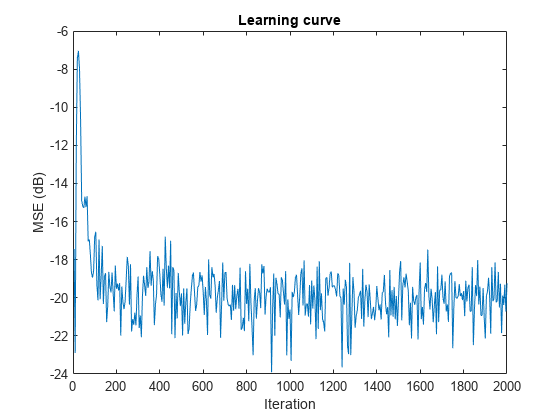dsp.AdaptiveLatticeFilter
Adaptive lattice filter
Description
The dsp.AdaptiveLatticeFilter
System object™ computes output, error, and coefficients using a lattice-based FIR adaptive
filter.
To implement the adaptive FIR filter object:
Create the
dsp.AdaptiveLatticeFilterobject and set its properties.Call the object with arguments, as if it were a function.
To learn more about how System objects work, see What Are System Objects?
Creation
Syntax
Description
alf = dsp.AdaptiveLatticeFilteralf. This System object computes the filtered output and the filter error for a given input and
desired signal.
alf = dsp.AdaptiveLatticeFilter(len)AdaptiveLatticeFilter
System object with the Length property set to
len.
alf = dsp.AdaptiveLatticeFilter(Name=Value)Length to
16.
Properties
Usage
Syntax
Description
[
filters the input y,err] = alf(x,d)x, using d as the desired
signal, and returns the filtered output in y and the filter error in
err. The System object estimates the filter weights needed to minimize the error
between the output signal and the desired signal. You can access these coefficients by
accessing the Coefficients property of the object. This can be done
only after calling the object. For example, to access the optimized coefficients of the
alf filter, call alf.Coefficients after you pass
the input and desired signal to the object.
Input Arguments
Output Arguments
Object Functions
To use an object function, specify the
System object as the first input argument. For
example, to release system resources of a System object named obj, use
this syntax:
release(obj)
Examples
References
[1] Griffiths, Lloyd J. “A Continuously Adaptive Filter Implemented as a Lattice Structure”. Proceedings of IEEE Int. Conf. on Acoustics, Speech, and Signal Processing, Hartford, CT, pp. 683–686, 1977.
[2] Haykin, S. Adaptive Filter Theory, 4th Ed. Upper Saddle River, NJ: Prentice Hall, 1996.
Extended Capabilities
Version History
Introduced in R2013b

![Figure contains 4 axes objects. Axes object 1 with title In-Phase Components, xlabel time index, ylabel signal value contains 3 objects of type line. These objects represent Desired, Output, Error. Axes object 2 with title Quadrature Components, xlabel time index, ylabel signal value contains 3 objects of type line. These objects represent Desired, Output, Error. Axes object 3 with title Received Signal Scatter Plot, xlabel Real[x], ylabel Imag[x] contains a line object which displays its values using only markers. Axes object 4 with title Equalized Signal Scatter Plot, xlabel Real[y], ylabel Imag[y] contains a line object which displays its values using only markers.](../../examples/dsp/win64/QPSKAdaptiveEqualizationUsingAdaptiveLatticeFilterExample_02.png)
